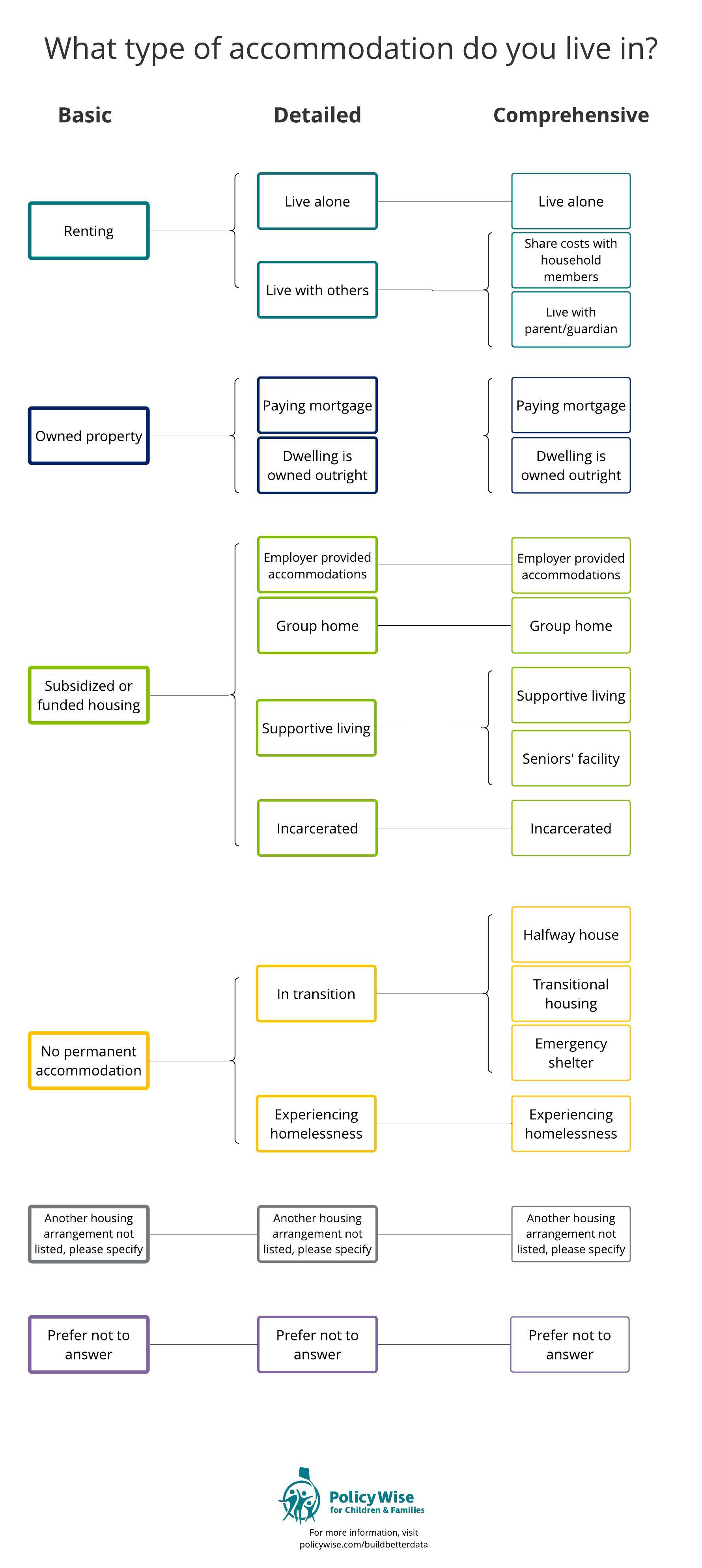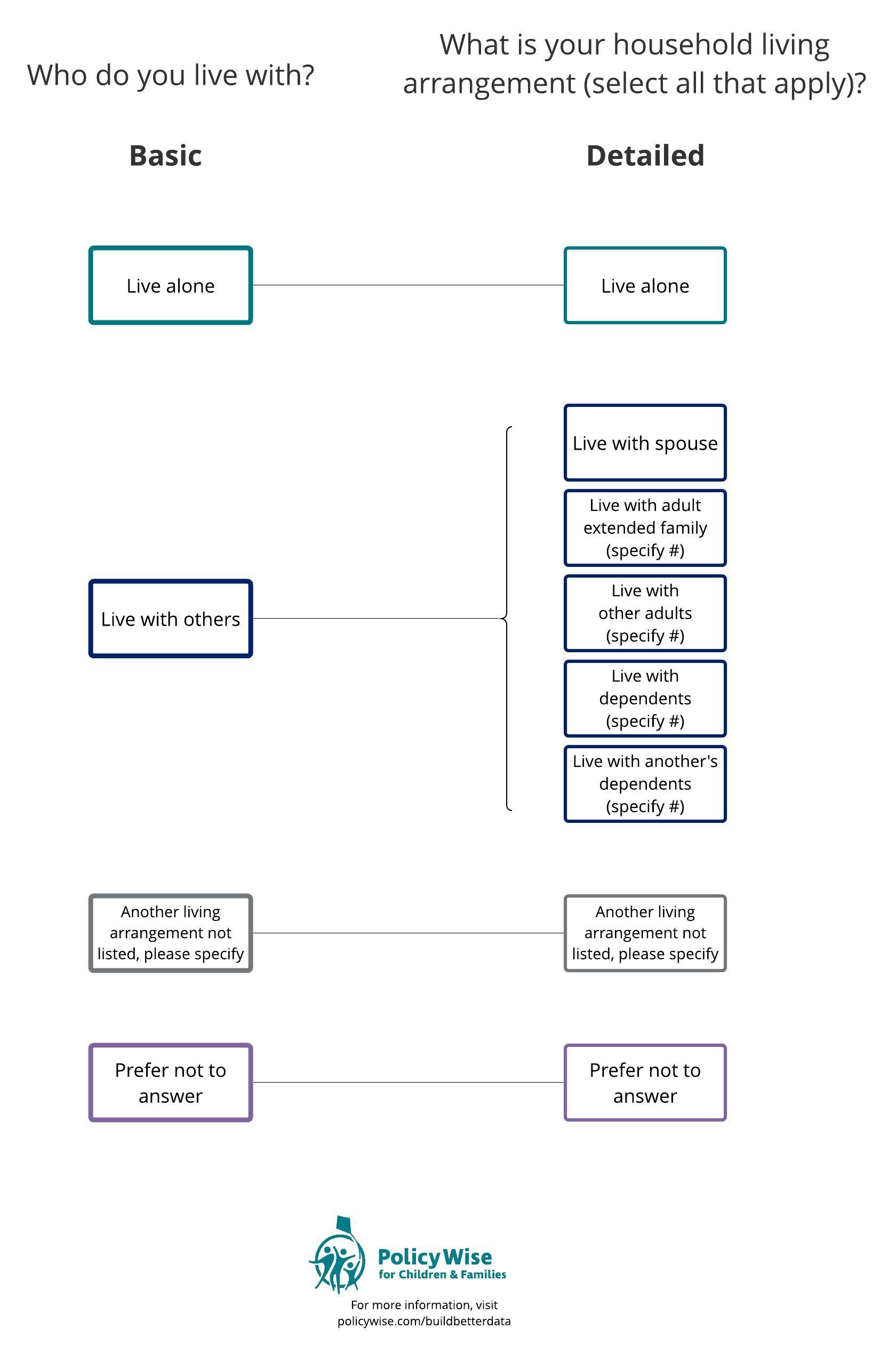Demographic Datapedia Entry:
Housing
Each Datapedia entry begins with definition(s) of the demographic variable followed by some considerations and limitations of the variable for understanding populations of people.
Next, a suggested question(s) and response options are shown. Note that this is given as guidance rather than a prescription of what’s best as that will depend on the information needs and context of your organization. Also included are ideas and examples of how to ask questions about the demographic variable in conversation.

Plan
It’s important to invest time in seeking out your “Why?” with data to ensure the data collected support your information needs. For more on this, see the Plan section of the Data Lifecycle.
Finally, a diagram is shown to illustrate basic, detailed, and comprehensive response options for the variable.
- The basic options are the minimum set of response options that are suggested for each variable.
- The detailed and comprehensive categories illustrate more detailed and nuanced response options that may be important to consider depending on your information needs and organization’s context.
- The diagram of response options show how each category can be collapsed into the basic set of answers. For example, the detailed and comprehensive response options can be collapsed or aggregated into the basic response options for analysis.
- Consider all response options when deciding on which category best suits your organization’s needs.
Importantly, the suggestions and details of the response options will need to be revisited and revised periodically to reflect shifts and changes that may emerge in various variables over time.1

BUILD
For ideas on how to collect and record quality data see the Build section of the Data Lifecycle.
2.1 Definition
A. Housing refers to the living accommodations of individuals or families.2
B. Living arrangements can include living alone or with others (family, dependents, spouse, roommates, etc.).
2.2 Considerations and Limitations
Housing can be used to understand:
- Eligibility for potential subsidized housing programs.3
- As a social determinant of health that can affect an individual’s physical and mental wellbeing.4
- How the housing budget may affect their budgeting based on the individual’s income level.5
- Effective housing situations varying from individual to individual and is important to understand what their preferred housing situation is e.g., disabled, client in recovery, etc.6
- The impact on an individual’s quality of life and well-being.7, 8
Housing cannot be used to understand:
- Relationship with other roommates or family members that may affect their living situations (e.g., abuse or trauma).4
Additional Considerations:
- Financial stability and other monthly expenses along with housing payments (e.g., debt, child support, etc.).9
- How often has a client moved during a certain time frame can help establish why frequent moving is occurring for the client.10
- How long has an individual stayed at their current address?
- Complicated housing situations.4
- Poor housing conditions can affect a client’s quality of life and wellbeing (e.g. leaky roof, plumbing problems, mould, etc.)11, 12
2.3 Suggested Collection Methods
The minimum suggested data collection method, or “basic” option reflects a synthesis of practices, considerations from nonprofit stakeholders, and recognized standards in capturing demographic data. The suggested method is modeled after what might be asked on an intake form during an initial meeting with a client. The process by which intake or registration occurs can vary widely depending on the context within which you are working. For example, the way questions are asked and data are recorded will vary for clients in crises, as compared to walk-in or drop-in sessions, or when registering for a program that requires people to meet certain eligibility requirements. In those cases, the suggested collection method can be used as a starting point but adapted to fit the needs of the context within which the data are being collected.
As a standard practice we suggest always including an option for people to write in an answer that may not fit within the options provided, along with an option not to answer. These are both important for creating inclusive demographic questions.1, 13, 14
2.3.1 Basic Question(s)
1. What type of accommodation do you live in?
- Renting
- Owned property
- Subsidized/funded housing
- No permanent accommodation
- Another housing arrangement not listed, please specify: _______
- Prefer not to answer
In conversation, the question may be phrased as:
- Tell me about your housing situation.
- Who do you live with?
- How are you paying for your house/apartment/etc.?
2. A. Who do you live with?
- Live alone
- Live with others (roommates, spouse/partner, dependents, extended family)
- Another living arrangement not listed, please specify: _________
- Prefer not to answer
2. B. What is your household living arrangement? (Select and fill all that apply).
- Live alone
- Live with spouse?
- Live with adult extended family. Specify number ____
- Live with other adults. Specify number____
- Live with dependents. Specify number____
- Live with another’s dependents. ____
- Another living arrangement not listed, please specify: _________
- Prefer not to answer
2.3.2 Diagram of Response Options
The diagram shows an overview of the basic, detailed and comprehensive response options. The options are not necessarily exhaustive, but they are modeled after what organizations may want to provide depending on the needs and context of their work. The question can be found at the top of the diagram and the response choices are mapped into the basic, detailed, and comprehensive levels. Not all variables warrant all levels of response options.

COLLECT
For considerations on building trust and relationships through data collection see the Collect section of the Data Lifecycle.


LENSES
You may wish to approach your data collection work through the lens of a particular framework or set of guiding principles, which will shape how you think about your response options. For more details, see the Lenses section of the Data Lifecycle.
To create the diagram for variable responses, two main sets of sources were used.
- Organization intake and registration forms from nonprofit subsectors across Alberta.
- Best practices in data collection, academic literature of demographic data, and resources from data aggregators (e.g., Statistics Canada, National Institutes of Health).
Findings from these sources were synthesized and organized across three levels of response options: basic, detailed, and comprehensive. To learn more please see the full methods. Datapedia Project Approach and Acknowledgements.pdf
Footnotes
-
Frederick, J. K. (2020, November 18). Four strategies for crafting inclusive and effective demographic questions. Ithaka S+R Blog. https://sr.ithaka.org/blog/four-strategies-for-crafting-inclusive-and-effective-demographic-questions/
-
Statistics Canada. (2020, December 31). Canadian housing survey. www23.statcan.gc.ca/imdb/p2SV.pl?Function=getSurvey&SDDS=5269.
-
Government of Alberta. (n.d.). Affordable housing programs. www.alberta.ca/affordable-housing-programs.aspx.
-
Mullins, P., Western, J., & Broadbent, B. (2001, March). The links between housing and nine key socio cultural factors: a review of the evidence positioning paper. Australian Housing and Urban Research Institute. https://www.ahuri.edu.au/__data/assets/pdf_file/0018/2736/AHURI_Positioning_Paper_No4_Links_between_housing_and_nine_key_socio_cultural_factors.pdf
-
Organisation for Economic Cooperation and Development. (2020, October 9). National Accounts of OECD Countries. www.oecd-ilibrary.org/economics/national-accounts-of-oecd-countries_2221433x.
-
Beamish, J. O., Carucci Goss, R., & Emmel, J. (2015) Lifestyle influences on housing preferences. Housing and Society, 28(1), 1-28. https://doi.org/10.1080/08882746.2001.11430459
-
Taylor, L. (2018, June 7). Housing and health: An overview of the literature. Health Affairs. www.healthaffairs.org/do/10.1377/hpb20180313.396577/full/
-
Braveman, P., Dekker, M., Egerter, S., Sadegh-Nobari, T., & Pollack, C. (2011, May 1). How does housing affect health: An examination of the many ways in which housing can influence health and strategies to improve health through emphasis on healthier homes. Robert Wood Johnson Foundation. www.rwjf.org/en/library/research/2011/05/housing-and-health.html
-
Boston Medical Center. (2020, February 24). Social determinant screening not enough to capture patients at risk of utility shut-off: EHR-based screening only captures 16% of those experiencing difficulty paying utility bills. ScienceDaily. www.sciencedaily.com/releases/2020/02/200224152658.htm
-
Marmot, M., Wilkinson, R. (2003). Social determinants of health: the solid facts (2nd ed). World Health Organization Regional Office for Europe. www.euro.who.int/__data/assets/pdf_file/0005/98438/e81384.pdf
-
Statistics Canada. (2020, December 31). Canadian housing survey. www23.statcan.gc.ca/imdb/p2SV.pl?Function=getSurvey&SDDS=5269
-
Statistics Canada. (2021, February 19). Housing suitability and dwelling condition, by tenure including social and affordable housing (Table 46-10-0043-01). https://www150.statcan.gc.ca/t1/tbl1/en/tv.action?pid=4610004301
-
Fernandez, T., Godwin, A., Doyle, J., Verdin, D., Boone, H., Kirn, A., Benson, L., & Potvin, G., (2016). More Comprehensive and Inclusive Approaches to Demographic Data Collection. School of Engineering Education Graduate Student Series, 60. http://docs.lib.purdue.edu/enegs/60
-
Lesbian, Gay, Bisexual, & Transgender Equity Center. (n. d.). Good practices: Demographic data collection. University of Maryland. https://lgbt.umd.edu/good-practices-demographic-data-collection
Do you have additions to suggest to the Datapedia? Or, do you want to learn more about working with data?
We’d love to hear from you. Contact us at info@policywise.com.




